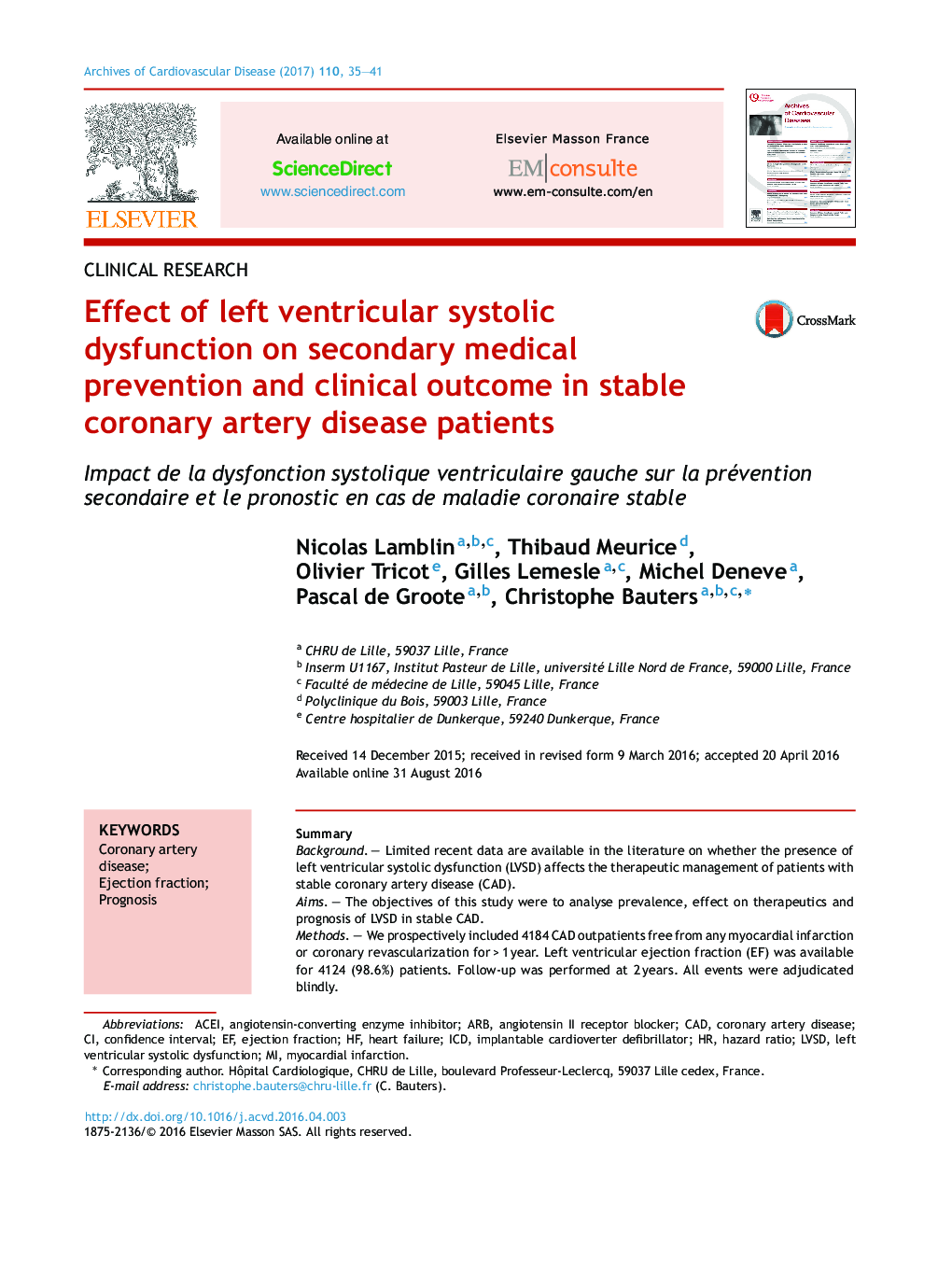| کد مقاله | کد نشریه | سال انتشار | مقاله انگلیسی | نسخه تمام متن |
|---|---|---|---|---|
| 5598843 | 1574328 | 2017 | 7 صفحه PDF | دانلود رایگان |
SummaryBackgroundLimited recent data are available in the literature on whether the presence of left ventricular systolic dysfunction (LVSD) affects the therapeutic management of patients with stable coronary artery disease (CAD).AimsThe objectives of this study were to analyse prevalence, effect on therapeutics and prognosis of LVSD in stable CAD.MethodsWe prospectively included 4184 CAD outpatients free from any myocardial infarction or coronary revascularization for > 1 year. Left ventricular ejection fraction (EF) was available for 4124 (98.6%) patients. Follow-up was performed at 2 years. All events were adjudicated blindly.ResultsThe mean EF was 57.5 ± 10.8%, and 201 (4.9%) patients had an EF â¤Â 35%. The prescription of renin-angiotensin system inhibitors and beta-blockers was inversely related to EF, and reached > 90% in patients with EF â¤Â 35%. Seventy-five (37.3%) of the patients with EF â¤Â 35% received a mineralocorticoid receptor antagonist. Eighty-five (42.3%) of the patients with EF â¤Â 35% had an implantable cardioverter defibrillator. Clinical follow-up data were obtained for 4090 patients (99.2%). Event rates were higher in patients with low EF (adjusted hazard ratio [95% confidence interval] for EF â¤Â 35%, with EF â¥Â 60% as reference: 3.93 [2.60-5.93] and 7.12 [3.85-13.18], for all-cause death and cardiovascular death, respectively).ConclusionsIn patients with stable CAD, LVSD is well taken into account by cardiologists, with extensive use of evidence-based medications and interventions. Despite this, LVSD remains a major prognostic indicator in this population.
RésuméContexteIl n'existe que peu de données concernant l'impact de la dysfonction systolique ventriculaire gauche (DSVG) sur la prise en charge des patients présentant une maladie coronaire stable.ObjectifAnalyser la prévalence, l'impact sur les thérapeutiques, et le pronostic de la DSVG en cas de maladie coronaire stable.MéthodesNous avons inclus 4184 patients coronariens ambulatoires, sans antécédent d'infarctus du myocarde ou de revacularisation coronaire < 1 an. Une mesure de fraction d'éjection ventriculaire gauche (FEVG) était disponible pour 4124 (98,6 %) patients. Le suivi clinique a été réalisé après 2 ans. Tous les événements ont été adjudiqués en insu.RésultatsLa FEVG moyenne était de 57,5 ± 10,8 % et 201 (4,9 %) des patients avaient une FEVG â¤Â 35 %. La prescription d'antagonistes du système rénine-angiotensine et de bêta-bloquants variait en sens inverse de la FEVG et atteignait > 90 % en cas de FEVG â¤Â 35 %. Au total, 37,5 % des patients avec FEVG â¤Â 35 % recevaient une anti-aldostérone ; 42,3 % des patients avec FEVG â¤Â 35 % avaient un défibrillateur automatique implantable. Un suivi clinique a été réalisé pour 4090 patients (99,2 %). Les événements étaient plus fréquents en cas de FEVG basse (HR ajustés [IC 95 %] pour une FEVG â¤Â 35 % [FEVG > 60 % en référence] : 3,93 [2,60-5,93] et 7,12 [3,85-13,18], pour la mortalité totale et la mortalité cardiovasculaire, respectivement).ConclusionEn cas de maladie coronaire stable, la DSVG est bien prise en compte par les cardiologues avec une large utilisation des thérapeutiques et interventions recommandées. En dépit de ce niveau de prise en charge, la DSVG demeure un facteur pronostique majeur dans cette population.
Journal: Archives of Cardiovascular Diseases - Volume 110, Issue 1, January 2017, Pages 35-41
